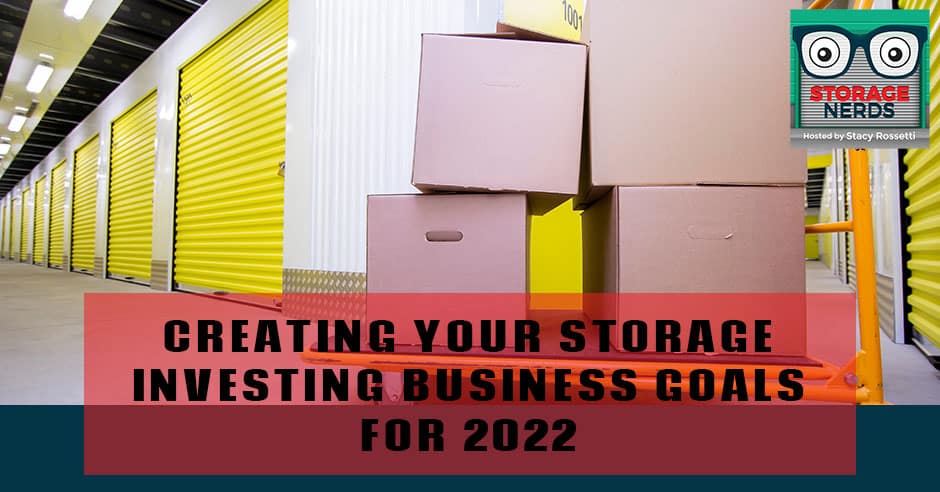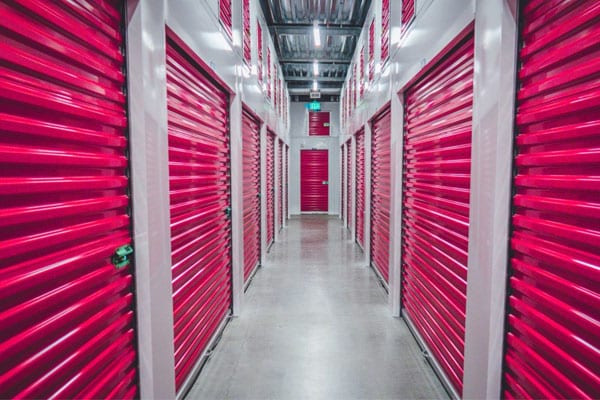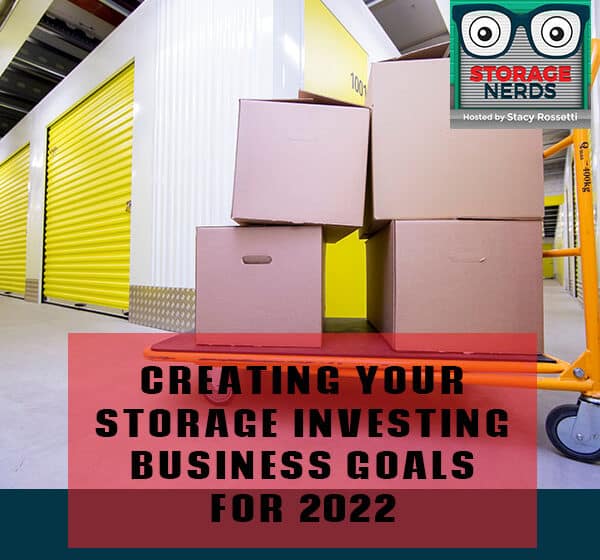
Stacy Rossetti is back to redirect, re-establish, and realize her storage investing business goals for 2022. Welcoming another year ahead, Stacy already has a lot of plans in mind. Stacy shares her latest storage facility acquisitions and what else she has planned for the rest of the year. To kickstart your business this year, Stacy is here to teach us their self-storage six step concept on how to get started with storage investing. Listen in as Stacy goes through the six step system and the three most important things from these steps that you should start working on right now.
—
Watch the episode here
Listen to the podcast here
Creating Your Storage Investing Business Goals for 2022
Setting Up Your Goals For 2022
I hope everybody had a great holiday. We were hanging out here in New York, hanging out with family and doing the family thing. Not a lot happened for us. I hope you had a great holiday season. It’s finally over. We are going to talk about the one thing that probably nobody wants to talk about, which is your business goals and setting up your goals for 2022.
I thought this would be a good topic. I’ve been thinking about this a lot. I started working on my business goals in October 2021. I do all my business goals in October of every year. I’m with one of those types of people but I don’t like to procrastinate and get everything done at the last minute. We already have all of 2022 planned out, pretty much working on finalizing our traveling.
As most of you know, we live in an RV and travel full-time. That’s the final thing that I have not finalized yet. I’m working on that and trying to get that all planned out. We’re going to have such a great 2022. I have a lot of awesome things planned for the business. I’m pleased to announce that we have 2 storage facilities under contract and a 3rd one that should be under contract. We’re working on a fourth one to see if we can work the numbers out as well too.
I’m going to tell you all for 2022 that we got it down. We can be buying some storage facilities. I am super excited about that. I have a great acquisitions person. His name is Chris and he is working hard at finding those deals. The way that we fund our deals is my job. I’m always raising money. I will be pitching two properties that we have under contract. If you’re interested in those pitches or in working together, you should hop on those calls. We’re going to email it out. You will see an email from me on the deal. If you’re not on my email list, what you should do is go to StacyRossetti.com and click on the Investors tab. That is how you can get on my email list.
Self-Storage Six Step System
We’re going to talk about your storage investing business goals. A lot of you guys are newbies. The doors are open for StorageNerds if anybody is interested in that program. I want to talk about trying to set up your goals for 2022 in the storage investing world. I’m going to go through my super simple self-storage six-step system. A lot of you know about this but if you don’t know about it, essentially, it’s the six steps that I teach on how to get started in storage investing. We’re going to go through that.
Three Things To Move Forward
Your job is to go to the Facebook group. If you’re not in the Facebook group, you need to go to Facebook.com and type in StorageNerds.com. That will take you to the Facebook group, Facebook.com/groups/storagenerds. Under the guide’s template is a page that we’re going to be using. If you want something to take notes or write down, essentially these are the three most important things from each of these steps that you should be working on. That is what we’re going to be working on in this episode.
From my 6-step system, out of each of the 6 steps, what are the three things you should be working on to move forward? That is the goal. That’s our topic. You’re going to want to go to Guides. Under Guides, you’re going to see all the guides and the 2022 Storage Investing Goals worksheet. You could share your goals here if you want to. After it’s done, put it out there to the world and hold yourself accountable. I want to see if anybody fills this out. We can all hold each other accountable.
You can print this out. Essentially, it’s the three most important things that I should be working on within reach of the departments of my storage investing business. I could put those here. You can have this sheet that you can put on the wall. I’m a very visual person. You could use it as your manifestation tool for 2022.
You should know how to separate your business from your personal life.
I’m a big manifestation person. When I first got started in real estate investing, I did my organizational chart. I put myself at the top, all the departments of my business and then I put me so I was running everything. It was me. As I started growing, whenever I could replace myself with somebody else in that department, I would put a new organizational chart up.
The first person I got was the office admin person. I changed my name and put Sarah because the first person I hired was Sarah. I was excited. I was like, “That’s one of my departments gone.” I would say like, “I’m going to start focusing on my other departments.” The only thing that I want to do is find the money. That’s what I’m good at. In all of those six departments that you see there on the sheet, I would love to know which one are you good at? What’s the one that sticks out to you?
Are you the back-office, marketing, acquisitions, finance, management or liquidations person? I am a money person or a finance person. I love talking about money, strategizing about money and creative deal structuring. That’s what I love. Out of all of these departments here, as a self-storage or real estate investor, these are the six departments in your business. Which of these? It could be 1 or 2. It might be marketing, acquisitions or something like this. This is your end goal.
For everybody reading, you can always go to StacyRossetti.com and click on Blog to see the video or you can find us on YouTube as well. We have the departments. Let’s go through the 6-step system and get you, whatever speaks to you, the 3 most important things that you should be working on to move forward. Everybody’s in a different place or journey. Whatever speaks to you is what’s working.
1. Setting Up Your Office Admin
The very first thing that you should be doing is setting up your office admin. When I say office admin, I’m talking about what you need to set up to start looking for deals. This is the very first step in the process. For me to get started, what I envisioned that everybody needs are, first of all, a phone or a phone number that you can use to receive calls and make calls.
Whether or not you use your personal number, a business line or whatever it is, in my life, I have my personal number and a business line. That business line is only the voice line. I’m using that for all my business stuff. All my family and friends know my personal number. You need to have some phone and phone number that you can use because when you start looking for facilities, you’re going to be calling, leaving a voicemail, sending out letters, texting or things like this. You want to separate your business from your personal life.

You also need some way to manage everything on your phone. That’s why I said phone and phone number. Do you want to be electronic or virtual? What I do is manage everything in the cloud. We’ve posted this out before. I have the most important apps that I have on my phone that I use on a regular daily basis in my business. I use Google Drive all the time.
Whether or not you use Google Drive, Basecamp, Dropbox or whatever you use, it’s the way that you want to do that. You want to have something set up so that you can find files on your phone and desktop easily but especially on your phone when you’re out and about. I also use Google Photos because of what happens once you start getting out there and looking for facilities. It’s also on the residential side when you’re looking at houses.
Every facility starts to look the same. When I’m out, talking to owners and looking for storage facilities, every facility looks the same. The way that it works for us in our company is if I’m out and I find a storage facility, I’m like, “That’s a good storage facility.” I want to see if the owner wants to sell. We take a picture of that facility and the sign.
We also use Lane Guide to look up the information on the property. I talked to Jennifer. She’s a student of StorageNerds. She says she uses an app called Parcels, which is free. I’m like, “We should try that one too.” I’m going to check out Parcels. I don’t know what the difference between Lane Guide and Parcels is, but Lane Guide is my best friend in the whole world.
Everything that we do, desktop and on the phone, is through Lane Guide. I am looking up everybody’s information no matter where I’m at. I want to know who owns which property within a 3-mile radius of me. I’m here in New York. It’s my father-in-law’s house. I’m looking and seeing who owns all the properties. What do they all sell for? I’m doing that all through Lane Guide. All public data on every single property is through Lane Guide. When I’m out and driving, I use Google Photos to store all my pictures. What I do is I create albums in Google Photos.
It’s 2022. Be virtual, be electronic, start getting into the habit of running your business from your phone.
That album will be titled Austin, Texas 9-22-21, something like that or wherever I’m out driving for storage. We create these folders in Google Photos. What I do in Google Photos is I share that album with my acquisitions person. I love Google because everything can be shared within it. In Google Drive, we share all of our sheets, files and documents.
Google Photos, I can share with everybody on my team. They can come in and see all my photos or whatever photos we want to share. That’s why I stick to Google. What I’m saying is that it is the 21st Century. It’s 2022. Let’s be virtual, electronic, in the cloud and start getting into the habit of running your business from your phone. That’s what you want to do. Can you run your business from your phone?
Ultimately, in the end, your goal is to own buy-and-hold properties. You want to have them as passive as you possibly can. The only way you can do that is if you start creating those habits. All the storage facilities that I’ve ever bought have no idea what I’m talking about. Let’s be virtual and start that habit. Is anybody not on Google Drive or in the cloud and they’re like, “No, I still do paperwork. I’m still old school?” Those are the people that I’m talking to that are totally old school.
You need to be in the cloud and manage your business from your phone. The phones are awesome. They can manage everything. You got to start taking advantage of that. Another thing about office admins and I’m not going to get into but we will get into this into our bootcamp is structuring your business. How do you structure your buy-and-hold properties so that you are protected?

Is it LLCs and S corps? Do you do land trust? I’m not going to get into that because, first of all, that’s not my true expertise. Secondly, my husband handles that for us and he loves teaching that. That’s part of office admin. Have you structured your businesses correctly so that if you do come across a property that you want to put under contract, you are not putting it under contract in your name? You don’t want to do that. That comes under office admin as well too. That’s a good start for office admin.
2. Get Your Marketing Going
Let’s do the next step. We’re setting up our business and getting everything on the back office set up so that we can start taking calls. The next step is getting your marketing. There are a lot of different ways for you to find facilities. That’s the question. How are you going to find your facilities? For me, which everybody knows, I drive for storage. That’s my favorite way.
If anybody here has ever tried to find storage facilities to purchase, what is your one favorite way that you find your facilities? My favorite way is driving for storage. You can call property owners. You have to call them anyway to talk to them. You can go on Crexi, LoopNet or MLS. I do not prefer these ways because it’s so expensive. I’ve never ever bought anything off of Crexi or LoopNet.
Only the very first deal that I ever found was on the MLS. It was years ago when nobody wanted to buy storage facilities anyways. It had been on the market for a few years. It’s hard to find any properties on MLS. They are as bad as Crexi and LoopNet. That’s one way that you can do it. You can also use Google Maps to find properties. Search Near Me and then you can find all the storage facilities near you and call them.
The hidden market is the facilities are not on Google Maps. It’s finding those facilities. What you can do too is you can buy a list and send letters. That’s a good handful of ways on how to find properties for marketing purposes. We have tried and done all these. Mostly what we do is we call owners and drive for storage. In the bootcamp, we go over twenty different ways for you to find storage facilities, but I wanted you to at least get an idea of some of the ways that you can do it.
Negotiation is all about connection, authenticity, vulnerability, and listening and communicating in the right ways.
You want to pick three ways. You don’t want to sit there and say, “I do all of this.” You want to pick three different ways to find storage and then those are the three that are going to go onto your business goals for the marketing sheet. We’ve got our marketing going, started calling and talking to owners. We started getting some people that want to sell. We have to put this thing under contract so that falls under acquisitions, which includes, first of all, filling out get all the details that you need about the deal so you can analyze it. You need to do a deal analysis.
What that means under deal analysis is that you need to be asking these typical questions. What are the total units? What’s the total square foot square footage. What’s the unit mix? Is there any extra land? What’s your annual income? What are your expenses? You don’t need to know their expenses. You need to know what your expenses are but some people feel that you need to know their expenses.
You need to know what their taxes are going to be. What do they pay in taxes? What are you going to be paying in taxes once you close on the deal? That deal may be valued differently. They may be tax-paying taxes on $200,000 and you’re buying it for $400,000. It’s going to get re-evaluated and paying taxes on $400,000. That’s how it works. There’s a whole bunch of different questions that you need to be asking, taxes, income and square footage.
Is there a vacancy? Are they full or not full? There’s a difference between economic and physical occupancy. Physical occupancy means, “I’m 100% full.” We’re 100% full on our facilities but how many people are paying? The paying occupancy is the economic occupancy. We’re 100% full but we’re only 89% economic occupancy, something like that.
Contract Negotiations
You need to be able to put this thing under contract. You need a contract that you can use to put offers in or an LOI. Sometimes people do LOI. Some people make contracts. I’ve always ever made contracts. When you get into huge big deals, they’ll want an LOI. We’re buying a $1 million facility. We put an offer in our contract. The owner is like, “Where’s the LOI?” I’m like, “I don’t do LOIs. I put the contract in. Let’s sign the contract.” He was like, “Where’s the LOI?” I told him, “Contracts is what we do.” You need to put this under contract and learn how to fill the contract out properly. Within the contract, what you need to do is you have to learn how to negotiate the terms.
Within acquisitions, one of the most important things that you can learn is how to negotiate the contract. Negotiation is what’s going to make or break the deal. From the negotiation, it’s all about authenticity and vulnerability, especially in the smaller deals. You get into huge big deals that are not even $3 million but maybe $5 million-plus. We closed on a $3 million deal.

The owners were like you and me. They were regular people who wanted to be heard and know that you were going to be taking over their baby and taking care of it. Negotiation for me is all about connection, authenticity, vulnerability, listening and communicating in the right ways. There’s a guy named Jamie Miller. What he does is he teaches the art of negotiation. He is going to be coming to the StorageNerds Coaching Program on January 18th, 2022. I’m so excited.
Anybody that’s a student of StorageNerds, on January 18th, 2022, Jamie is coming. All he’s teaching is the art of negotiation for investors. He focuses on investors and how to help you to talk to owners better, negotiate your contract terms and learn how to be better at connecting with people. We have such amazing guest speakers coming up.
Negotiation is key. We have deal analysis and learning how to do deal analysis. This is commercial real estate investing. In commercial real estate investing, you have to learn how to run deal analysis on commercial property. Within the commercial real estate investing realm, you’ll have multifamily, retail storage and a whole bunch of different kinds of commercial. The concepts are very similar once you learn how to run commercial deal analysis.
You can run commercial deal analysis on any type of deal. You have to learn for each of the types of niches what’s typical in that niche, cap rate in multifamily, retail or storage. The concept of commercial deal analysis is the same almost across the board. I love that because I love storage. I’ll always be a storage person but for instance, we got a facility under contract. It is a storage facility plus commercial property. It’s a mixed-use property plus an apartment complex. That is all in one thing.
Those kinds of deals come across your plate when you’re out talking to storage facility owners. They own a whole bunch of stuff that they want to sell all of it. It’s all or nothing. This is one of those deals where it’s a storage facility and then it’s got some different types of rental property that they have in commercial rentals. They also have a regular apartment.
Commercial Deal Analysis
With commercial deal analysis, we have to run the numbers on the apartment differently from the commercial retail space and the storage space. It’s all the same but you can’t run a commercial property like that at a price per square foot. In storage, it’s all about price per square foot but in the apartment and also in the retail spaces, it’s value different.
The phones are awesome nowadays. They can manage everything and you have to start taking advantage of that.
Learning commercial deal analysis, when you start getting into it, is going to open up the doors to all different types of commercial property, which is super exciting. Learning how to do commercial deal analysis is the hardest part of the equation. In the end, once you start learning and it starts clicking, it opens up your world to so many other different types of properties out there. The truth of the matter is that you never know what’s going to come across your plate. You want to be open to all types.
Creative Deal Structuring
You have commercial deal analysis. We have a contract and negotiation. Negotiation falls into making offers, learning how to truly make offers, connecting and also making offers that make sense for the deal. What I mean by that is you are not going to live in a box. In the commercial world, you can’t live in a box. You can’t have one way of thinking. You have to do what’s called creative deal structuring.
With creative deal structuring, what that means is that you’ve listened to what the owner’s needs are and compile an offer based on those needs. You can do things like making a cash offer. You make an offer, “This is my cash offer,” or you might have to go to a bank. That might be a little bit different offer or you can do an owner financing and get them to go by the bank. You can do things like bring equity partners in.
Based on the deal and what comes across your plate, there are so many different ways to put the deal together. To get the owner to do something like this, you have to learn how to do each of those. Creative deal structuring and learning how to structure deals are imperative in the commercial real estate space.
Commercial real estate is expensive. Little tiny deals, you could do a couple of these. Yourself, maybe but as the truth of the matter is, the meat is in the middle, even though I don’t eat meat or way bigger deals. You want to learn how to use other people’s money to do a whole bunch of different kinds of bigger deals so that you can make more money on the back end.
I was talking to a student before and he was like, “I want to make $150,000 passive income.” I said, “You have to break that down into how much is that going to be for every single month. What type of facility is going to facilitate these types of deals for me?” You could do 1 or 2 bigger deals, super big deals or a handful of medium deals or a whole bunch of little deals. It’s up to you. There’s no right or wrong way to do it. 6 one way, 1/2 dozen the other. Some people like to do a couple of big deals.

I have one student that’s like, “No, I want to do five $5 million deals.” Me, as well, too. We like smaller bills. That’s what we do and how we’re good at it. The question is, what kind of deals are good for you? How can you leverage the people around you and other people’s money to do the types of deals that you need to do and achieve the goals that you want? The way that you do that in the commercial world is to create a deal structuring. This is a very important thing that you’re going to be learning once you start getting into commercial real estate.
That’s acquisitions. We’re going to go into finance. My favorite thing is the money. This is where you’re going to learn how to raise money. You can put creative deal structuring under this as well because creative deal structuring is two-fold. It’s structuring the deal on the acquisition side and raising the money under the Finance Department. Both of those work together and they work at the same time.
You’ve got to find the deal, get the deal under contract and structure it. At the same time, you should be raising money and learning how to structure the deals. You can find private money lenders as private money lenders. Raising money is always getting out there, talking to people and seeing if they’d be interested in lending you the money or partnering with you on the deal.
Asset-Based Lending
In the previous webinar that I did, the last session was all about private money and how to raise private money. If you’re interested, make sure that you check that out. You are learning how to raise private money and then also utilize it if you need hard money lenders. These are all lenders that will lend you money but at a higher interest rate. They’re more like a bank concept. This one is called asset-based lending. It’s like bank lenders that lend on most any type of facility but at a higher interest rate. There are some out there. We have several that come and talk to our group, StorageNerds, regularly.
You also have bank financing. This could be either SBA or local banks. We have one of our SBA lenders that comes 2 or 3 times a year and talk to the StorageNerds. He’s going to give us an update on all the SBA loans that are out there, the rules, the regulations and what you should be looking out for SBA loans. Local banks or SBA banks for income-producing properties are perfect. Income-producing property money is 75% or more full.
Cheaper is not always better.
If it’s 75% or less full, those are more mismanaged facilities. The 50 to 75% full is a gray area. Some banks will say, “That’s not a good deal for me. I’m not going to lend on that.” SBA sometimes says, “We’ll lend on that.” It’s a gray area. Let’s see what happens in 2023 with the banks. I honestly think lending is going to get more and more difficult.
The recession is going to happen. It’s going to be a little bit tougher to find the money. They’re going to want more down. Back in the day, you could do 10% down and go to 15% and 20%, then it’s 25% down. I have a student that’s borrowing around $800,000 or so. He has to put 25% down. Between 20% and 30%, it could go up to 30% with loans. That’s another reason why you want to learn how to raise money.
When I say creative deal structuring, I didn’t put this down but owner financing is part of creative deal structuring. For instance, we’re about to get a facility under contract. It’s 217 units and we’re getting it under contract for $1 million. It’s not worth $1 million. It’s probably worth $600,000. We’re paying way more over than what we should. It’s not making the income. It’s 30% to 40% full. The owner isn’t into it but we were going to pay $1 million for it.
He’s going to owner finance it for us. His terms are $250,000 down. He will owner finance it to us for 10 years at 5% interest, amortized over 20 years. That’s the same loan you go to a bank and get. That’s what I told him. I didn’t even bring it up. I was going to put it into my fund. He said, “Would you be interested in owner financing?” I said, “Yeah, but what are your terms going to be? I could go to a bank and get a loan.”
He said, “It’ll be the same terms as a bank would do.” I said, “I’ll want to finance it through.” I have to come up with $250,000 down. I’m not going to pay that. All I do is go out and find somebody to bring $250,000 into the deal. We partner on the deal. I’m no money into the deal. That’s creative deal structuring. We’ll do probably a 60/40 split where I get 60% and they get 40% because I’m the one that brought the deal and I should be making more money.
On the backend, that facility should be worth at least $2 million, if not more. It will take us a little while to get up to that point. Essentially, in the next couple of years, we’ll sell that, make $1 million and split it. That’s a good deal. I put no money into that deal. That is creative deal structuring. That is what you have to learn how to do. We’re on our 11th facility and we’re going to be buying 3 more. That’s how I do it. That is finance.
3. The Management
We got the money. We’re going to buy the facility because we found the money and then manage it. The management part is the hardest. Everybody’s always like, “How do you find and fund them?” Nobody ever thinks about how you run the suckers. The truth of the matter is that when you buy a storage facility, you are buying a retail business. If you don’t run it properly, that retail business is going to be run to the ground.
You’re going to have a business that I buy in the next years, which is exactly what happened to the one that I’m going to buy. The owner has six facilities that are all right next to each other. He bought this other one that’s an hour away. These five facilities over here, he’s doing well with those. That one that’s way out, he doesn’t want to do anything with that.
He said, “I’m older. I don’t feel driving out an hour to go manage that thing.” He’s not online and doing anything properly. All of our facilities are all over Georgia and Florida. They’re all within 2, 3, 4, 5, 6 hours away from us. Once you learn how to manage them virtually like you’re running your business virtually, you can truly make these passive incomes. Management equals passive income.
Passive income is not like, “I’m going to be netting $2,000 a month.” Passive income is when you can live in an RV, travel full-time and manage eleven facilities. Passive income is how you manage your facilities. I love to people talk about passive income all the time. The truth of the matter is, do you have to be near that facility to manage it? If you do, then it’s not passive income.
I told my husband in 2019 like, “We have to get to the point where we can step away, travel, spend time with Lillian and do the things that we want. We have to focus on getting these all completely virtual.” In 2019, that’s what we did. We focused on automating and systematizing everything. In 2020, we could go full-time.
Management equals training your tenants. It means putting your foot down, running your business like a business and not being one of those suckers that let your family come in and take 2, 3, 4 units. I have a student with a storage facility and he’s afraid to raise the rent. I was like, “You’ve got to rip the Band-Aid.”
Ripping the Band-Aid means as soon as you buy that facility, you’ve got to raise the rent. Whoever wants to leave, leave. All the tenants in there that are going to follow your rules fall under training your tenants. You are going to run this as a business and not a hobby. You are going to be completely electronic through your property management software.
You’ve got to get a good one. Cheap is not always better. You want the software that has all the bells and whistles on it so that you can take advantage of all it has to offer so that you can completely automate and systematize everything. A lot of people go with the cheapest one and then they realize later that it was not the right decision.
Luckily, we went with storage. You can automate everything in storage. Electronic and automation are key to managing everything. Be completely virtual. In all of our facilities, there is no office anywhere. Our office manager and customer service person are out of their house. Our boots on the ground person are the only person that sees our facilities.
We don’t even see our facilities. Our boots-on-the-ground person is the eyes and ears of our facility. Our two back-office people manage all of the automation and property management. High-level stuff is what we do. We do numbers, strategies and things like this. My husband’s job is to close the deal. Once we get it under contract, I find the money. My husband’s job is onboarding. That’s what he does.

He’s closing the deal, working with the attorney and the software company to onboard everything. Once we onboard it, our operations person takes over and manages it or a customer service person answers the phone and tries to get the contract signed and stuff like this. We are a lean, mean self-storage and investing machine. That’s what I call it. That all starts from the very first step, which is getting that back-office setup and setting up the foundations of your business so you can be completely virtual.
Finally, liquidations. What I mean is that are you going to buy an income-producing property, go to a bank, get a loan, have that property and hold onto that property forever? Are you going to hold onto it for a couple of years, sell it, 1031 exchange it or owner finance it? I’m about to buy a facility and he’s owner financing it to me. We also are open to owner financing our facilities to other people when we are ready to sell them. Owner financing is probably one of the best ways for you to make passive income. You’re the bank. You’re the lender and lenders are the ones that make money in real estate. Owner finance, 1031, owners change, cash-out refi is what I’m talking about.
This is part of liquidations. This is to the point where it’s up running and making money. I’ve got a P&L and a balance sheet. I can do this with it. That’s where you want to be. This is your end goal. You want to be in the position where you can say, “I’m going to hold onto this sucker. I’m going to make a couple of $100,000 on this deal. Let me 1031 exchange this thing to a bigger deal. I don’t want to buy any more property. I’m tired of properties. I’m going to owner finance this thing and move on.” It’s exactly what happened to one of the facilities I’ve bought.
We closed because I asked the guy like, “Do you finance this?” He said, “I don’t want to finance it.” I said, “Why?” He’s like, “I don’t want to buy more properties anymore. I’m tired of property.” I was like, “I want to be you when I grow up.” This is your end goal and where you want to be. You want to be in a position where it’s like, “I have these options here.” Those are your six departments. Remember, the doors for StorageNerds are open.
If you’re interested in joining StorageNerds, you have to set up a call with us. You have to go to StorageNerds.com and apply, set up a call with me. We can talk about whether or not the coaching program is the right fit for you. I hope you enjoyed this session. What are the three things that every single one of my departments should be focusing on?
Moving Forward
I’d like to know what your goals are for 2022. I want specific tasks. What are the next things that you need to be doing to move forward and make your owning a storage facility come to fruition? What are those goals and tasks that you need to do? Everybody here wants to buy a storage facility. We all get that. What are the next three things that you need to do to buy your storage facility?
When it comes to goals, the more specific you are about what you need to do, the more of a chance you’re going to accomplish that. Gone are the days when you need to have 3 and 5-year goals. Who has time for that? I need to have some goals to get to the next step and the next deal. That’s what I’m talking about.
Our bootcamp that’s coming up on January 22nd and 23rd of 2022 is going to be a lot about management. If you’re there, you’ll going to be like, “I need to fine-tune my management.” One of my students when he joined, in 90 days, he’s got his facility under contract. In his mind, he’s like, “I’m still trying to wrestle with how the whole management process is going to work.” He’s going to be a perfect candidate for the bootcamp coming up as well too. I get that because when he first started, he had no idea how even to find a storage facility, analyze it or put it under contract.
Now he’s like, “How is this whole management thing going to work?” If you’re thinking that, you have to come to the bootcamp because we will walk through all of that. You have to talk to as many owners as you possibly can. I tell my students you have to talk to 10 owners a week, not call 10 people. The reason why is because when you call 10 owners, maybe 1 is going to want to sell.
Storage facility owners do not answer the phone. You can’t just call 10 people and try it 10 times. You have to talk to them. That’s how you count your numbers. The coaching program is $1,000 a month. I get it. It’s an investment. If you’re truly like, “I’m going to do this. This is it,” those are the people that I want to talk to. If you’re like, “I’m not going to spend it down. It’s not my thing,” don’t even set an appointment with me because I want to talk to people that are not going to take action.
I’m here for you on Monday nights. I’m available. For all the coaching students, I will see you at our mastermind. I am looking forward to it. Don’t forget that that sheet is under Guides in the Facebook group. Make sure that you join the Facebook group and click Guides. For all the students, everything is in coach accountable but for non-students, we made that sheet. You can go into Guides and download that. I appreciate everything. I will see you at the next session. I look forward to talking to everybody interested in StorageNerds. Take care.
Important Links
- StacyRossetti.com
- Investors
- StorageNerds
- Facebook.com
- Facebook.com/Groups/StorageNerds
- Blog – Stacy Rossetti
- YouTube – Stacy Rossetti Teaches
- Basecamp
- Lane Guide
- Bootcamp – Getting Started in Self-Storage Investing Bootcamp with Stacy & Pete Rossetti
- Crexi
- LoopNet
- MLS
- Jamie Miller


